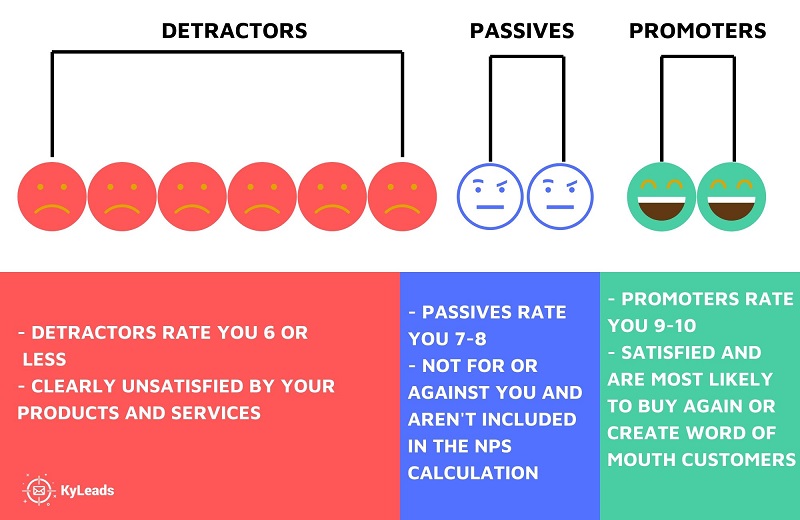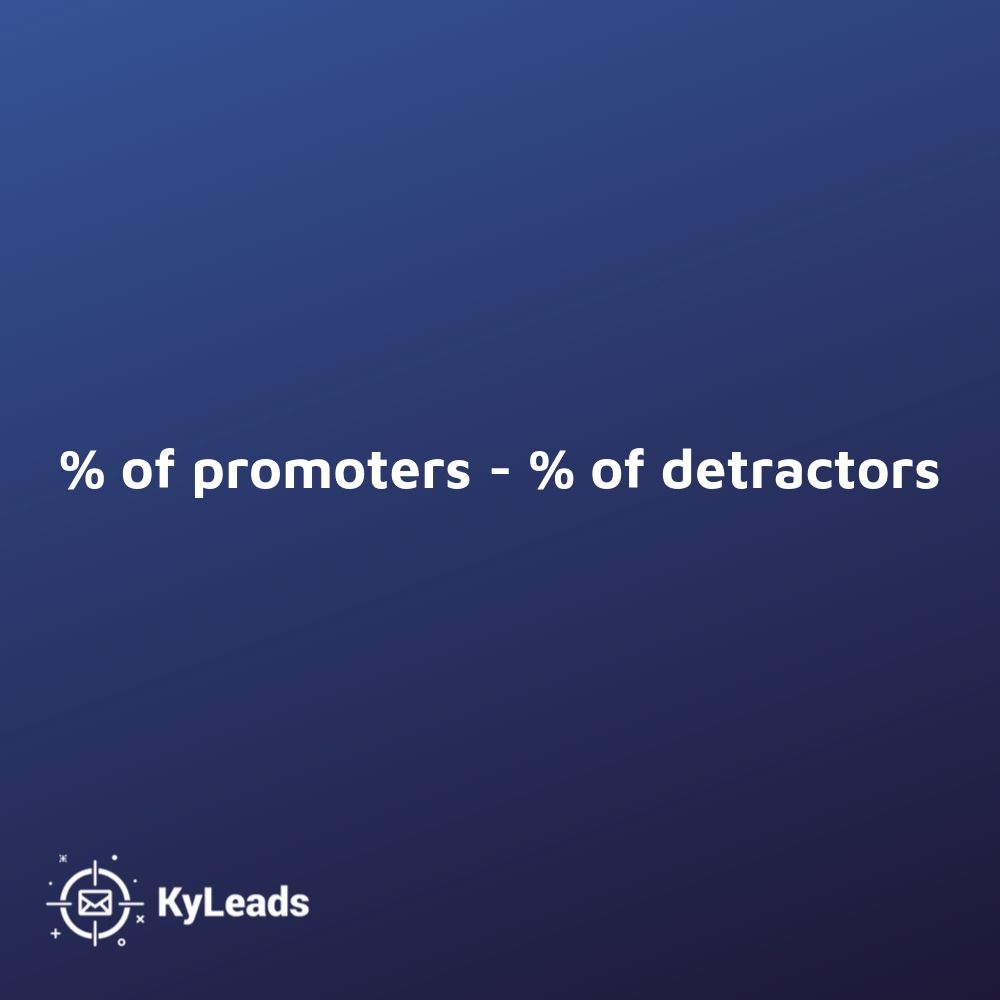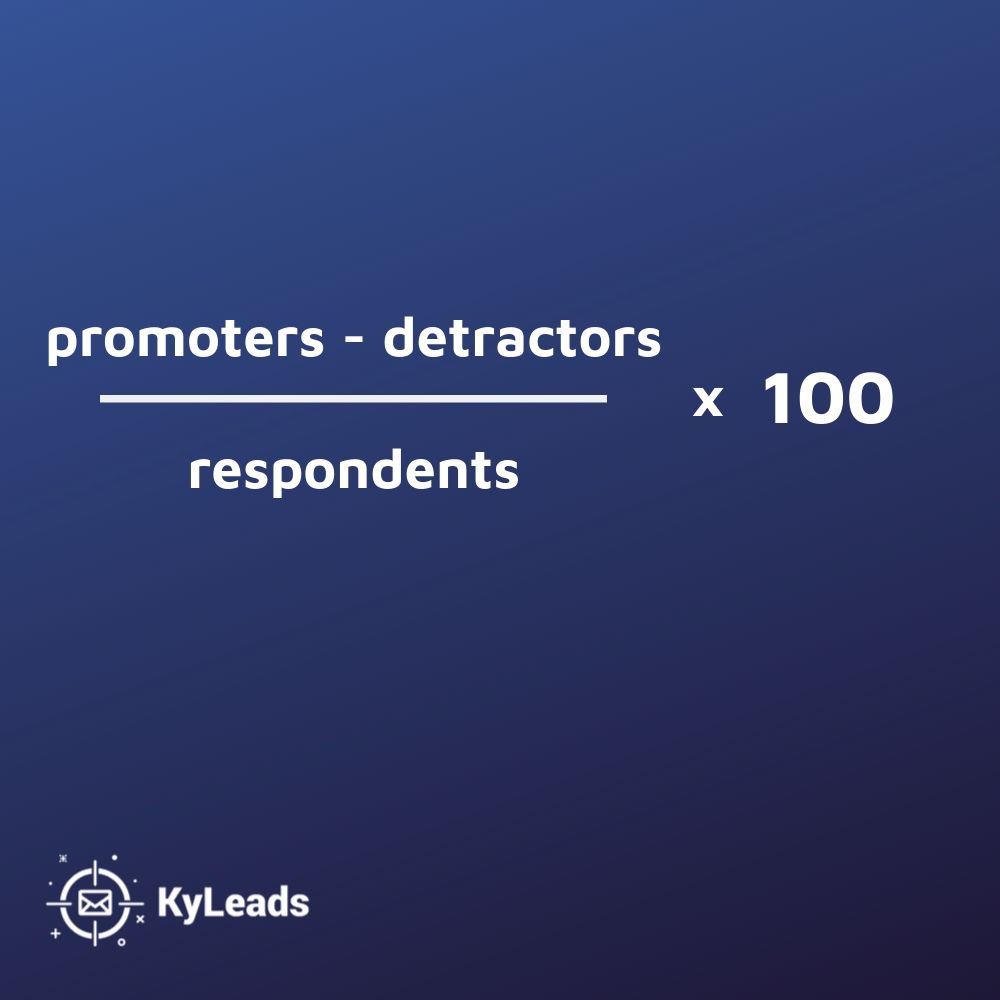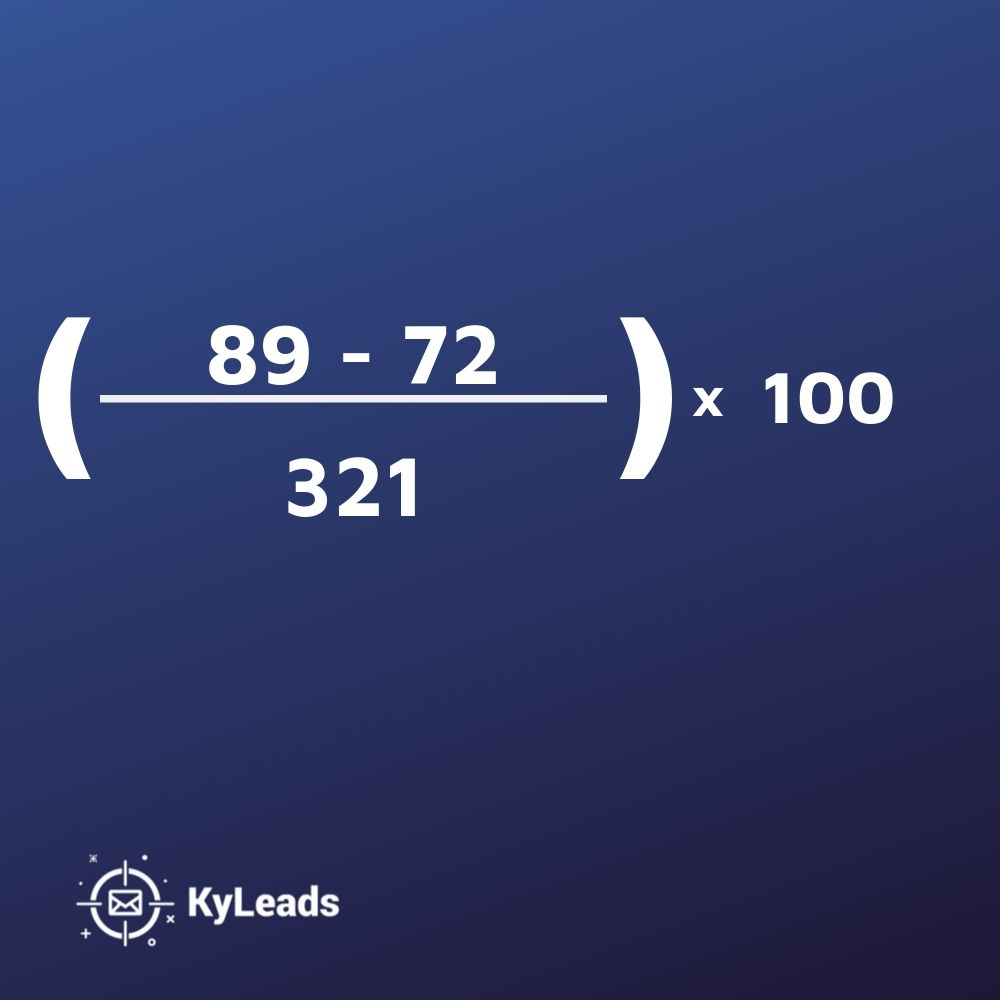When you know what your magic sauce is you can do amazing things with it. The ability to answer the questions “how loyal are my customers?” or “are they willing to recommend us to other people?” and even “what are we doing right (or wrong)?” gives you a clear edge.
Previously, finding this info was a challenge that required deep research and an expensive consulting firm or two. Now, it’s as simple as sending out a Net Promoter Score® survey and watching the answers roll in.
In this article, you’ll learn what the Net Promoter Score® is, how to calculate it, and different times and ways to use it.
Table of Contents
What is the Net Promoter Score®
The Net Promoter Score® (NPS), as the name suggests, is a measure of how willing your customer or audience is to promote your business, products, or services to others. Put another way, it’s an index ranging from -100 to 100 which measures how willing customers are to recommend a company to others. It’s used to gauge satisfaction as well as loyalty.
You can think of it as a simplified CSAT survey that only asks one question – at times two. The respondents are divided into three groups depending on their replies:
- Detractors who aren’t happy with your organization/products
- Passive who aren’t happy or unhappy
- Promoters who are happy and willing to share your company with their social circle

We’ll look deeper into the nuances of NPS surveys later in this guide. For now, let’s focus on why Net Promoter Score® is important.
Measures loyalty
NPS is an index that serves as a proxy for how loyal your customers are to your business. If someone is happy then they stick around and also tell other people (promoters). When they’re getting a service they find valuable but think it could be better, they may stick around but are at risk of jumping ship at any time (passives). If they’re unhappy then they’ll be gone as soon as they can find something better (detractors).
Since the NPS functions as a “proxy” for gauging the breadth of loyal brand advocates, dismantling detractor feedback provides targeted insights to improve experiences at risk of erosion. Though the “proxy” NPS metric quantifies promoter satisfaction levels, analyzing qualitative passives’ commentary spotlights incremental optimization opportunities with those teetering between staying or leaving.
Rather than relying solely on the “proxy” score snapshot, periodically re-surveying customers meters progress on enhancements for once passive wanderers now nudged into promotion. While the aggregated “proxy-store” number signals overarching loyalty trends, examining the “proxy” in relation to retention statistics and revenue paints a complete picture of enduring user allegiance.
NPS helps you identify each group and the reasons why they feel that way. With those insights, you can figure out how to create more happy customers and reduce the unhappy ones. The better your NPS, the less likely the average customer is to churn or seek solutions elsewhere which lead to higher retention and more profit. In some cases, 25% – 95% more profit.
There is no good score the first time you send out an NPS survey. Instead, look at your first Net Promoter Score® as a benchmark. Your goal from that point is to improve it and understand if you’re organization is getting better over time.
For example, if you have a lot of detractors the first time you perform an NPS survey you know what you need to work on. If detractors reduce and passives increase on the second survey then you know you’re making progress. When you perform a third NPS survey and the number of promoters reduces but passives increase then there’s a problem somewhere.
Identifies places to improve
An NPS survey consists of two parts. The first part gauges customer loyalty and is what the majority of people are familiar with. The second part is just as important. It asks the reason for the original score.
Without the second question, all you’d know is that someone is happy or unhappy about your company or services. How would you take action on that? The short answer is you can’t. When you ask respondents the reason for an answer, you’re able to get qualitative data that’ll equip you with the tools to improve or continue on the right path.
It transforms the NPS score from an abstract number to a metric that helps you make improvements in your business. The more specific the feedback is the better, after all, there are still trolls on the internet.
Helps you find people who are unhappy
For every single person that complains about something relating to your business, there are 26 people who are suffering in silence. There are a lot of reasons for this. One of them is time. It takes time to reach out and complain about issues.
An NPS survey helps reduce the time investment required by your customers. There is only one main question and an open-ended follow-up question where people can voice all of their opinions of your company in clear terms.
You can then use those answers to categorize and reach out to people who expect more from your service.
Used as a benchmark for future performance
This may be a bit controversial but we believe there’s no good or bad NPS score. Not in the way people think. For example, you shouldn’t aim for a score of 90 if your current score is -20.
Your immediate goal should be to improve it to – 10 or 0. The long term goal could be to get to 90. Whatever score you get the first time around is OK. What’s not OK is the score staying consistent over months or years. That’s when you have a real problem on your hands because it’s an indication that you’re not progressing.
Who created Net Promoter Score®
The Net Promoter Score® was developed and is jointly trademarked by Fred Reichheld, Bain & Company and Satmetrix. Though it has become popular with over 50% of the Fortune 1,000 using it, there are limitations associated with it.
Many critics claim that it doesn’t predict loyalty behaviors, the scale may not increase predictive validity, and it doesn’t add to other loyalty related questions. These are valid points and it just illustrates that there’s no single metric to judge customer loyalty. Instead, it’s important to use NPS surveys as part of a larger initiative to understand and improve customer loyalty.
Types of NPS surveys
When you first encounter Net Promoter Score®, it may seem like there’s only one way to perform them. That’s not exactly true. There are two major types of NPS surveys you can utilize.
The first one is the transactional NPS and the second one is the relationship NPS.
Transactional NPS survey.
This kind of survey goes out right after someone performs a transaction with your business. It helps gauge the experience they had buying the product or, if it’s something that can be accessed instantly, their feelings towards the product.
It helps you understand bottlenecks and places that can be improved as pertains to a specific product or funnel. In essence, you’re getting information about loyalty and customer satisfaction that pertains to a small window in time. It can be useful if you want highly specific and actionable feedback on something in your business. That could be a checkout flow, the quality of a product, etc.
Relationship NPS Surveys
These Net Promoter Score® surveys take a step back. It’s not focused on understanding loyalty as pertains to an individual experience. Instead, it’s focused on overall customer satisfaction and loyalty over time.
Instead of sending out the survey right after a transaction, it goes out at regular intervals. That could be every quarter, every month, every 6 months, etc.
The goal is to see how your NPS is trending over time. Is it getting better or worse? How is customer satisfaction doing? Do big updates or events have an impact on NPS over time or are there spikes only after releases?
Those are the types of questions relationship NPS can help answer.
Net Promoter Score® survey setup
The good thing about Net Promoter Score® is that the process to collect the information is simple. There’s a single question and depending on how they answer it, there’s a follow-up question.
The main question, can be tweaked to fit your situation and depends on whether you want feedback about a specific product, service, or your business and whether it’s a business or consumer product.
Here’s the question:
- On a scale of 0-10, how likely are you to recommend our business to a friend or colleague?
- On a scale of 0-10, how likely are to recommend (product/ service name) to a friend or colleague?
This question can vary. For example, if you lease coworking space, you can ask how likely they are to recommend your coworking space to a friend or colleague.
After the initial reply, you’ll know whether they’re a passive, detractor, or promoter. That will determine how you phrase your follow up question.
If they’re a promoter, you can use variations of the following questions:
- What’s the primary reason for your score?
- Which features do you value and use the most?
- How can we further improve your experience?
If they’re a detractor, you can use variations of the following questions:
- How can we improve our product/service to better meet your needs?
- What was missing from the product?
- What was disappointing about your experience with us?
If they’re passive, you can ask variations of the following questions:
- How can we make you a happier customer?
- What’s the primary reason for your score?
That’s it, once you get the responses back, it’s time to calculate your Net Promoter Score®.
Net Promoter Score® calculation
Just like the survey itself, the calculation is also straightforward. The final answer is always an absolute number between -100 and 100.
Let’s look at the formula to calculate NPS.
There are three types of people who respond to your Net Promoter Score® survey:
- Detractors which score you 6 and below
- Passives which score you 7-8
- Promoters which score you 9-10
The formula is % of promoters – % of detractors = NPS

or ((promoters – detractors) / respondents)) X 100 = NPS

Passives aren’t taken into account when calculating your Net Promoter Score.
Let’s look at an example to illustrate.
Acme Inc. sends out an NPS survey to its entire customer base and gets back 321 responses in a week. It decides to go ahead and calculate its score based on the data it has available.
There are 89 promoters, 72 detractors, and 160 passives.
It set up the following formula
((89 – 72) / 321) X 100

Their NPS is 5. As mentioned earlier, this isn’t good or bad (technically, it’s good because it’s above zero). Rather, it’s a benchmark they can use to measure their efforts against over time.
When and how to use Net Promoter Score®
There are countless ways to use an NPS survey to derive insights from your customer base. If you’re first starting out, it may not be useful because there simply aren’t enough customers to make it worthwhile. Instead of using an NPS survey, you may be better served by a standard CSAT survey or questionnaire.
After a transaction (transactional NPS)
I’ve already touched on this when explaining what transactional NPS surveys are. You use this survey right after someone performs a transaction with your business. It sheds light on how that transaction was perceived by the customer and what that means to your customer loyalty and satisfaction.
At regular intervals (relationship NPS)
This one is sent out to your customer base multiple times a year and helps you determine how the score is trending over time. It isn’t sent out after a transaction so that a specific experience won’t affect the overall score.
As a gauge of progress
This is where NPS surveys become powerful. NPS isn’t a one and done thing.
It’s important to understand that customer sentiment shifts over time. New trends come to light, needs evolve, and expectations change. Net Promoter Score® can help you determine if you’re keeping up with what’s expected from you.
In other words, it’s a simple and effective way to gauge your progress over time because it’s a snapshot of a specific moment. When you take multiple snapshots of multiple moments in time, you get a clearer picture.
The follow-up question continually gives you insights into what you’re doing wrong (and right).
Conclusion
Net Promoter Score® isn’t a perfect tool by any means so it shouldn’t be the only method you use to understand what customers think about your business. With that being said, it is a powerful way to gauge customer loyalty and satisfaction.
When used correctly, it can give you deep insights into problems with your organization as well as what you’re doing right.
This guide has walked through exactly what NPS is, how to use it, and how you can easily calculate it in your business. If you only take one thing away from it, understand that the Net Promoter Score® is something that should be used often. Start performing NPS surveys to understanding exactly what you need to do to build an exceptional company.
You are a professional